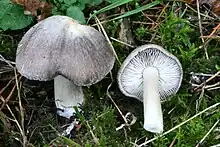| Tricholoma terreum | |
|---|---|
 | |
| Scientific classification | |
| Domain: | Eukaryota |
| Kingdom: | Fungi |
| Division: | Basidiomycota |
| Class: | Agaricomycetes |
| Order: | Agaricales |
| Family: | Tricholomataceae |
| Genus: | Tricholoma |
| Species: | T. terreum |
| Binomial name | |
| Tricholoma terreum | |
| Synonyms | |
| |
| Tricholoma terreum | |
|---|---|
| Gills on hymenium | |
| Cap is convex or flat | |
| Hymenium is adnexed | |
| Stipe is bare | |
| Spore print is white to cream | |
| Ecology is mycorrhizal | |
| Edibility is edible | |
Tricholoma terreum, commonly known as the grey knight or dirty tricholoma, is a grey-capped mushroom of the large genus Tricholoma. It is found in coniferous woodlands in Europe, and has also been encountered under introduced pine trees in Australia and New Zealand. It is regarded as edible. A 2014 article speculated that it may be poisonous,[1] but Sitta et al. in 2016 published in the same journal a counter article demonstrating the unfounded nature of such speculation.[2]
Taxonomy
The fungus was originally described as Agaricus terreus by Jacob Christian Schäffer in 1762, and as Agaricus myomyces by mycologist Christian Hendrik Persoon in 1794. It was given its current binomial name by German Paul Kummer in 1871. It is commonly known as the grey knight[3] from its discoloured gills.[4]
Almost all modern sources consider Tricholoma myomyces to be a synonym of T. terreum,[5][6][7] but there are some exceptions.[8] Bon mentions that T. myomyces has been defined for lowland mushrooms with white gills and a fleecy cap and Courtecuisse separates it on the same basis.[9][10] Moser distinguished T. myomyces on the basis that the gills should go yellow.[11]
Description
The cap is 4–7 centimetres (1+1⁄2–2+3⁄4 inches) wide and evenly covered in fine grey scales. Convex with a slight boss, it is broadly conical in shape. The whitish stipe is 3–8 centimetres (1+1⁄4–3+1⁄4 inches) high and 1.5 centimetres (1⁄2 inch) wide and has no ring. There is no ring or volva. The whitish flesh is thin, easily broken, and has a pleasant mild (not mealy) smell and taste. The widely spaced and uneven gills are free (unattached to the stipe). The spore print is white, the oval spores 6–7 μm long by 3.5–4.4 μm wide.[3][4]
It could be confused with the larger (and poisonous) T. pardinum has a mealy smell and cap scales; the edible T. orirubens has fine dark scales and pinkish gills.[12]
Distribution and habitat
Tricholoma terreum is found in Europe, where fruiting bodies appear under conifers, particularly pine and spruce, from late summer to late autumn.[3] They may also arise in parks near these trees, and grow in fairy rings.[4] They are generally in quite densely populated groups though not bunched. It has been recorded growing under exotic Pinus radiata plantations in Australia.[13][14]
Edibility
With a mild taste, the species used to be regarded as a good edible. It is seen in markets in France, along with Clitocybe nebularis and Tricholoma portentosum.[4] However, some authorities recommend that inexperienced pickers avoid all grey tricholomas.[15] Recent chemical tests show that this species may contain toxins which can cause rhabdomyolysis.[1] However, from more recent investigations it has emerged that only an abnormal quantity of Tricholoma mushrooms may trigger the rhabdomyolysis and normal consumption of about 200g of mushroom is safe unless there is an individual reaction.[16]
See also
References
- 1 2 Heping Xia: Fatal toxins found in 'edible' wild mushrooms, in: Chemistry World, 16 June 2014
- ↑ Paolo Davoli, Marco Floriani, Francesca Assisi, Karl Kob, Nicola Sitta: Comment on “Chemical and Toxicological Investigations of a Previously Unknown Poisonous European Mushroom Tricholoma terreum ”, in: Chemistry Europe. First published: 10 March 2016, doi:10.1002/chem.201406655
- 1 2 3 Phillips, Roger (2006). Mushrooms. Pan MacMillan. p. 107. ISBN 978-0-330-44237-4.
- 1 2 3 4 Lamaison, Jean-Louis; Polese, Jean-Marie (2005). The Great Encyclopedia of Mushrooms. Könemann. p. 89. ISBN 978-3-8331-1239-3.
- ↑ "Tricholoma terreum page". Species Fungorum. Royal Botanic Gardens Kew. Retrieved 2017-03-22.
- ↑ "Tricholoma terreum (Schaeff.) P. Kumm., 1871 Synonyms". Global Biodiversity Information Facility. GBIF. Retrieved 2017-03-22.
- ↑ "Tricholoma terreum (Schaeff.) P. Kumm., 1871 Synonyms". Dyntaxa (in Swedish). Swedish University of Agricultural Sciences. Retrieved 2017-03-22.
- ↑ Bessette AE, Bessette AR, Trudell SA, Roody WC (2013). Tricholomas of North America: A Mushroom Field Guide. Austin, Texas: University of Texas Press. p. 108.
- ↑ Marcel Bon (1987). The Mushrooms and Toadstools of Britain and North-Western Europe. Hodder & Stoughton. p. 154. ISBN 978-0-340-39935-4.
- ↑ Courtecuisse, R.; Duhem, B. (2013). Champignons de France et d'Europe (in French). Delachaux et Niestlé. p. 194. ISBN 978-2-603-02038-8. Also available in English.
- ↑ Meinhard Moser (1983). Keys to Agarics and Boleti. Translated by Simon Plant. London: Roger Phillips. pp. 129–130. ISBN 978-0-9508486-0-0.
- ↑ Haas, Hans (1969). The Young Specialist looks at Fungi. Burke. p. 144. ISBN 978-0-222-79409-3.
- ↑ Grey, Ed and Pat (2006). "FNCV FUNGI GROUP FORAY: LERDEGERG RIVER WALK, JACK CANN RESERVE, BLACKWOOD, 2 July 2006" (PDF). Royal Botanic Gardens Melbourne website- fungimap section. Royal Botanic Gardens Melbourne. Archived from the original (PDF) on August 29, 2008. Retrieved 2009-02-21.
- ↑ Keane, Philip J.; Kile GA; Podger FD (2000). Diseases and Pathogens of Eucalypts. Canberra: CSIRO Publishing. p. 84. ISBN 978-0-643-06523-9.
- ↑ Zeitlmayr, Linus (1976). Wild Mushrooms: An Illustrated Handbook. Garden City Press, Hertfordshire. pp. 72–73. ISBN 978-0-584-10324-3.
- ↑ Piotr Rzymski, Piotr Klimaszyk: Is the Yellow Knight Mushroom Edible or Not? A Systematic Review and Critical Viewpoints on the Toxicity of Tricholoma equestre, Wiley online library, first published: 25 July 2018, doi:10.1111/1541-4337.12374